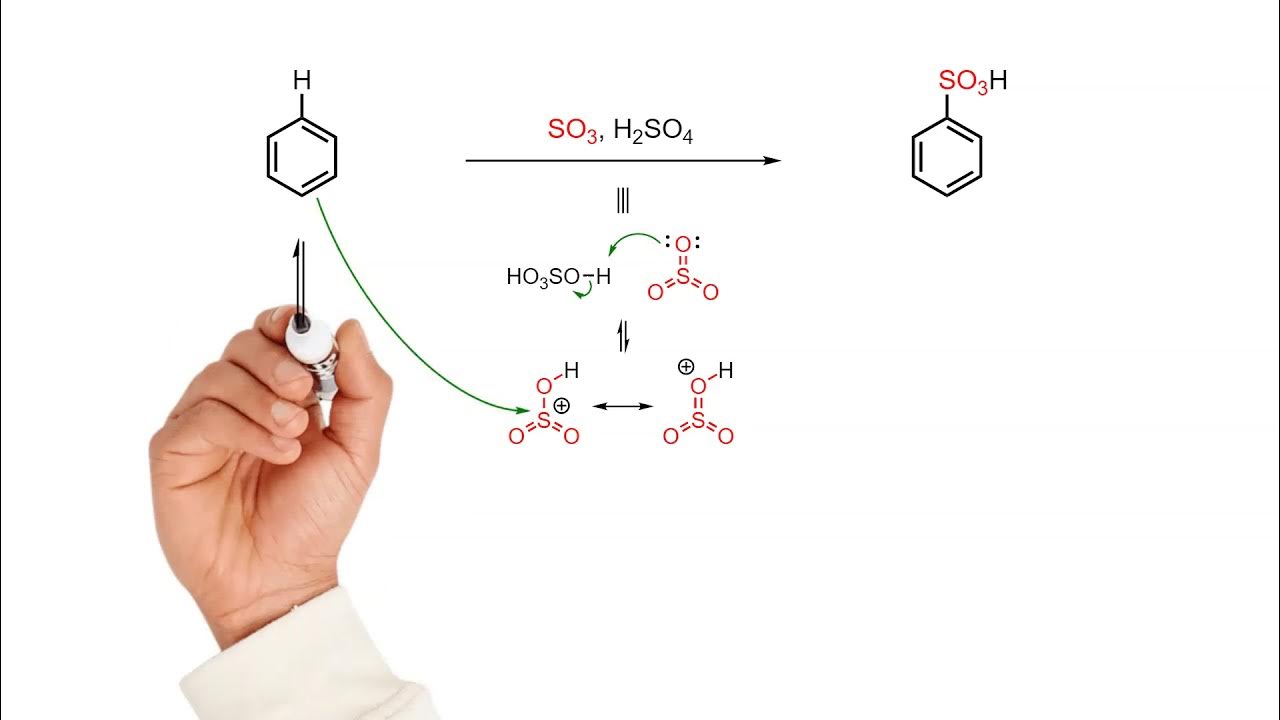Reaksi Benzena | Reaksi Alkilasi Friedel-Crafts: Mekanisme Reaksi dan Batasan Alkilasi [LENGKAP]
Summary
TLDRThis video explains the Friedel-Crafts alkylation reaction, a method for adding alkyl groups to aromatic rings like benzene. The reaction involves using an alkyl halide and a Lewis acid catalyst to form a carbocation, which then attacks the aromatic ring. The video details the reaction mechanism, the role of catalysts, and common limitations such as polyalkylation, carbocation rearrangement, and the influence of electron-withdrawing groups. It also discusses applications of the reaction in organic chemistry, including the synthesis of complex natural products and industrial chemicals, making it a vital reaction for both research and industry.
Takeaways
- 😀 Friedel-Crafts alkylation is a reaction that adds alkyl groups to aromatic rings through the formation of carbon-carbon bonds.
- 😀 This reaction is named after chemists Charles Friedel and James Crafts, who developed it in 1877.
- 😀 The reaction requires a catalyst, typically a Lewis acid like AlCl3, to facilitate the substitution of a hydrogen atom on the aromatic ring with an alkyl group.
- 😀 The Friedel-Crafts alkylation reaction is a thermodynamically controlled process that results in the formation of a stable product.
- 😀 The reaction proceeds through three stages: carbocation formation, electrophilic attack on the aromatic ring, and proton release to yield the alkylated product.
- 😀 The Lewis acid catalyst, such as AlCl3, enhances the reactivity of alkyl halides and facilitates the reaction by generating a stable carbocation electrophile.
- 😀 Friedel-Crafts alkylation is not effective with aryl halides and vinyl halides due to the instability of the carbocations they produce.
- 😀 One limitation of the reaction is polyalkylation, where multiple alkyl groups can be attached to the aromatic ring, leading to a mixture of products.
- 😀 Carbocation rearrangement can occur in the reaction, especially with primary alkyl halides, producing products that differ from the expected ones.
- 😀 The reaction works best with electron-rich aromatic rings, while aromatic rings with electron-withdrawing groups (like benzaldehyde) do not react effectively.
- 😀 Friedel-Crafts alkylation is widely applied in organic chemistry for the synthesis of complex natural products and molecules, although it has practical limitations compared to acylation reactions.
Q & A
What is the Friedel-Crafts alkylation reaction?
-The Friedel-Crafts alkylation is a substitution reaction that involves the replacement of a hydrogen atom in an aromatic ring with an alkyl group. It is used to form carbon-carbon bonds involving aromatic rings like benzene.
Who discovered the Friedel-Crafts alkylation reaction?
-The Friedel-Crafts alkylation reaction was discovered by chemists Charles Friedel and James Crafts in 1877.
What are the two main types of Friedel-Crafts reactions?
-The two main types of Friedel-Crafts reactions are alkylation and acylation. This video focuses specifically on the Friedel-Crafts alkylation reaction.
What is the role of a Lewis acid catalyst in the Friedel-Crafts alkylation reaction?
-The Lewis acid catalyst, such as aluminum chloride (AlCl3) or iron chloride (FeCl3), is crucial for generating a stable carbocation, which acts as the electrophile that attacks the aromatic ring in the alkylation reaction.
How is the carbocation formed in the Friedel-Crafts alkylation mechanism?
-The carbocation is formed when an alkyl halide reacts with a Lewis acid catalyst like AlCl3, creating a carbocation that is highly electrophilic and ready to react with the benzene ring.
What are the three main stages of the Friedel-Crafts alkylation mechanism?
-The three stages are: 1) Formation of a carbocation (the electrophile), 2) Electrophilic attack by the carbocation on the benzene ring to form a sigma complex, and 3) Proton release to form the alkylated product and regenerate the catalyst.
Why is the Friedel-Crafts alkylation reaction considered thermodynamically controlled?
-The reaction is thermodynamically controlled because it leads to the formation of a more stable product, especially when rearrangements of carbocations occur to form more stable structures.
What are some limitations of the Friedel-Crafts alkylation reaction?
-Some limitations include: 1) It cannot be used with aryl or vinyl halides, 2) It can lead to polyalkylation, 3) Carbocation rearrangement can produce unexpected products, 4) It does not work well with electron-withdrawing groups, and 5) It can be ineffective with strongly activated aromatic compounds like phenol.
Can the Friedel-Crafts alkylation reaction occur without a catalyst?
-Technically, the reaction can occur without a Lewis acid catalyst, but it would be slower, less efficient, and produce fewer desired products.
What are the applications of the Friedel-Crafts alkylation reaction in organic chemistry?
-The Friedel-Crafts alkylation reaction is widely used in organic chemistry, particularly in the synthesis of natural products and complex molecules. It plays a key role in the formation of alkylated aromatic compounds, which are important in various industrial and research applications.
Outlines

Dieser Bereich ist nur für Premium-Benutzer verfügbar. Bitte führen Sie ein Upgrade durch, um auf diesen Abschnitt zuzugreifen.
Upgrade durchführenMindmap

Dieser Bereich ist nur für Premium-Benutzer verfügbar. Bitte führen Sie ein Upgrade durch, um auf diesen Abschnitt zuzugreifen.
Upgrade durchführenKeywords

Dieser Bereich ist nur für Premium-Benutzer verfügbar. Bitte führen Sie ein Upgrade durch, um auf diesen Abschnitt zuzugreifen.
Upgrade durchführenHighlights

Dieser Bereich ist nur für Premium-Benutzer verfügbar. Bitte führen Sie ein Upgrade durch, um auf diesen Abschnitt zuzugreifen.
Upgrade durchführenTranscripts

Dieser Bereich ist nur für Premium-Benutzer verfügbar. Bitte führen Sie ein Upgrade durch, um auf diesen Abschnitt zuzugreifen.
Upgrade durchführen5.0 / 5 (0 votes)






